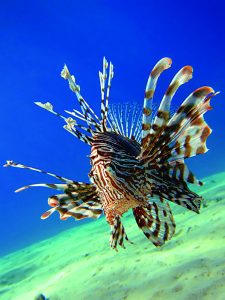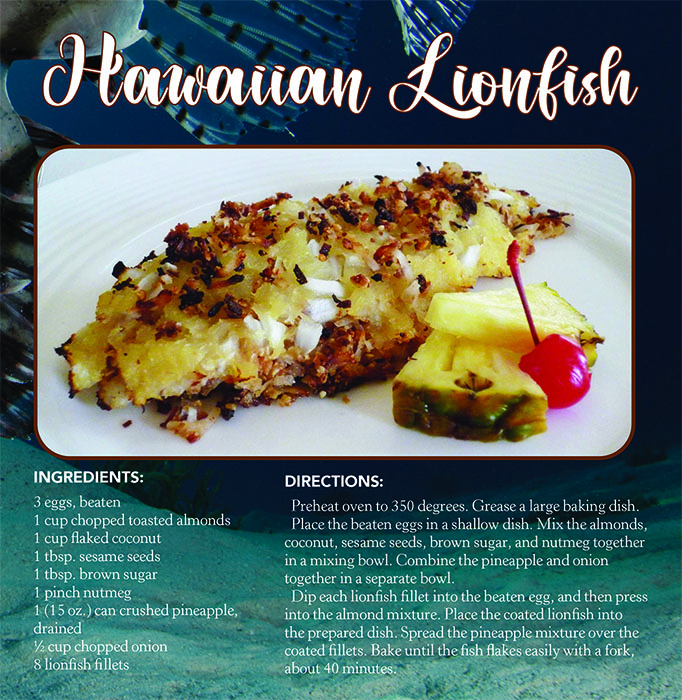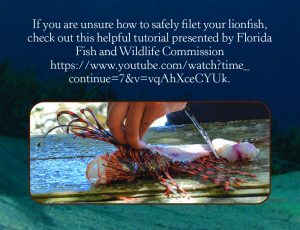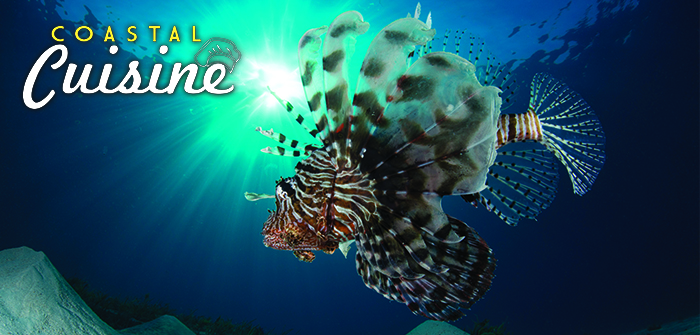Story by Anna Stockton
Have you been to one of our wonderful local seafood restaurants lately, looked at the menu and thought…. umm, lionfish? Well, you’re not alone, as these invasive fish attempt to wreak havoc on our waters, the Gulf Coast is fighting back in unconventional ways.
So what exactly are these spiny bundles of venom? There are two main kinds of lionfish in our area but the one that has affected the gulf coast the most is the red lionfish. Known for their vertical lines, tall dorsal spines and enormous pectoral fins, lionfish are easily recognizable. Lionfish are impressive hunters and use the cover of night to stalk their prey. They are usually found living in reefs or mangroves, but can  also make their home around man-made structures like piers and shipwrecks. They can grow up to 18 inches long, females start laying eggs when they reach around 7 inches long and lay around 2 million eggs per year. This, along with having no natural predators, makes lionfish a huge threat to our local marine life.
also make their home around man-made structures like piers and shipwrecks. They can grow up to 18 inches long, females start laying eggs when they reach around 7 inches long and lay around 2 million eggs per year. This, along with having no natural predators, makes lionfish a huge threat to our local marine life.
Native to the warm waters of the South Pacific and Indian Oceans, lionfish have found an equally hospitable environment in the waters of the Atlantic and Gulf of Mexico over the past few decades. The first documented sighting was in 1985. Since then, there have been many theories and folklore surrounding exactly how the lionfish came to be in our waters. One theory is simple, aquarium enthusiasts imported the lionfish for their collection and dumped them in the water when they grew too large. Another theory is an aquarium along Biscayne Bay was destroyed during Hurricane Andrew in 1992, releasing 6-8 lionfish and contributing to the already growing (however, small) population. A more farfetched idea is that the lionfish were accidentally trapped and transported in the ballast of a freighter. How ever these hardy guys got here, it appears they are here to stay.
The Florida Fish and Wildlife Commission is “spearheading” the effort to minimize the lionfish population here in Florida. Their annual Lionfish Challenge encourages recreational and commercial divers to safely remove lionfish from the population. Monthly, as well as tiered prizes, are awarded for catching the most lionfish. Pictures and FWC checkpoints are used to keep track of catches. This challenge was extended through November 1, more information can be found at myfwc.com/fishing/saltwater/recreational/lionfish/challenge/. Another program hosted by Florida Fish and Wildlife is the Lionfish Harvest Program, this allows commercial and recreational divers to be reimbursed for a portion of their lionfish dive charter. Go to www.fwcreefrangers.com for more information on this program.

The Gulf Coast is known for making the most out of every situation and that’s exactly how some restaurants are handling the lionfish population problem. Ingenuity and creativity by local chefs, combined with a desire to keep our waters healthy, have created a trend we can all be proud of. Lionfish can be  blackened, fried, barbequed, and combined with sauces and sides that will have you telling your friends. The lionfish spines are venomous, but once they’re safely removed it’s smooth sailing. The fillets are firm and white with a flaky texture and non-fishy taste, similar to a snapper or black sea bass. Demand is high for lionfish dishes as local restaurants are showcasing all the unique ways they can create something special while helping keep our eco-system healthy.
blackened, fried, barbequed, and combined with sauces and sides that will have you telling your friends. The lionfish spines are venomous, but once they’re safely removed it’s smooth sailing. The fillets are firm and white with a flaky texture and non-fishy taste, similar to a snapper or black sea bass. Demand is high for lionfish dishes as local restaurants are showcasing all the unique ways they can create something special while helping keep our eco-system healthy.

